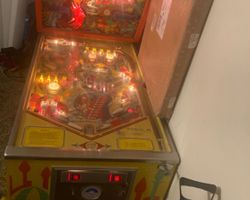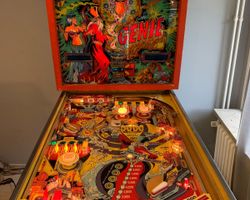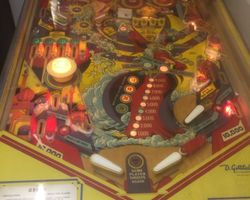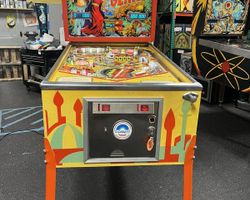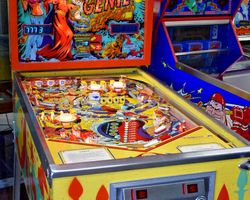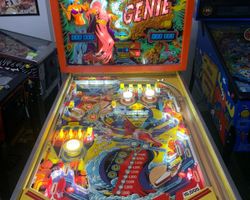Genie

Average Prices: USD $400 to $1,400
Produced: October, 1979
Production Run: 6,800 units
Machine Type: Solid State Electronic
MPU: Gottlieb System 1
Players: 4
Design by: Ed Krynski
Art by: Gordon Morison
"Genie," released in October 1979 by D. Gottlieb & Co., emerged as a distinctive entry in the pinball landscape, particularly notable for its widebody cabinet and ambitious design. At a time when solid-state technology was rapidly advancing, Gottlieb sought to push the boundaries of playfield real estate, offering players a sprawling canvas for their pinball pursuits. The machine's fantasy theme, centering on a mystical genie and Arabian nights imagery, was brought to life by the artistic vision of Gordon Morison, whose vibrant and detailed illustrations adorned both the playfield and the backglass. Ed Krynski, a prolific designer for Gottlieb, conceived the playfield layout, aiming to maximize the widebody’s potential with an intricate arrangement of targets and pathways. With a production run of 6,800 units, Genie represented Gottlieb's commitment to innovation within their System 1 platform, seeking to captivate players with both its expansive dimensions and its unique gameplay experience. Its introduction at an MSRP of $1350 positioned it as a premium offering in the late 1970s pinball market.
Signature Features and Design
Genie stands apart with several defining characteristics, most prominently its widebody cabinet, a design choice that profoundly influences its gameplay and aesthetic. This expanded footprint allowed for a more complex and varied playfield arrangement than standard-width machines. A standout mechanical feature is the presence of five flippers, two in the conventional lower position and three strategically placed in the upper playfield area. This configuration encourages multi-faceted shot-making and demands adaptive control from the player.
The machine also incorporates a substantial array of drop targets, specifically an impressive 7-bank and a 4-bank, which are central to scoring and objective progression. A spinning target adds another dynamic element, rewarding accurate shots with variable points. The artwork, primarily executed by Gordon Morison, is a key draw. His use of vibrant yellows, purples, and blues creates a captivating visual theme, depicting a mystical genie alongside intricate patterns and characters that evoke a sense of fantasy and wonder. This detailed, hand-drawn style enhances the machine's allure, making it a visually arresting piece of pinball history. The backglass, in particular, is frequently cited for its beauty and detailed composition, serving as a focal point for the machine's overall aesthetic.
Playfield and Mechanics
The Genie playfield is a testament to the potential of a widebody design, offering a vast and intricate landscape for the ball to traverse. The lower apron features the standard two flippers, but the playfield quickly expands into a more open middle section before narrowing into an upper, more congested area. A defining element is the prominent 7-bank of drop targets positioned on the left side of the mid-playfield. Directly opposite, on the right side, lies a smaller 4-bank of drop targets, providing distinct objectives for players to pursue.
Central to the upper playfield is an elevated mini-playfield, accessible via a narrow lane. This compact area is a game within a game, featuring its own set of targets and a single flipper dedicated to navigating this confined space. This upper section offers unique shot opportunities and often requires precise aim to activate its features. Surrounding these primary target banks are three pop bumpers, strategically placed to create chaotic, unpredictable ball movement, often feeding the ball back into target-rich areas. A single slingshot on the lower left adds to the reactive elements, propelling the ball with force.
The flow of Genie is distinct from many traditional layouts due to its wide format. Shots can feel deliberate and tactical rather than fast and flowing, often requiring precise aiming to hit distant targets or navigate the ball into specific lanes. Five star rollovers and four standup targets are distributed across the field, contributing to bonus scoring and mode progression. A kick-out hole offers a satisfying reward for hitting a specific target, launching the ball back into play. The lighting scheme complements the artwork, using illumination to highlight active targets and pathways, guiding the player’s focus across the expansive playfield. The overall aesthetic is cohesive, immersing players in the machine's magical theme through both its visual design and the physical layout of its components.
Gameplay Dynamics
Genie’s gameplay dynamics are characterized by a focus on target completion, bonus accumulation, and strategic flipper work across its expansive playfield. The primary objective often revolves around clearing the 7-bank and 4-bank drop targets. Hitting these targets not only awards points but also advances the bonus multiplier, a core mechanic that significantly influences high scores. Completing these target banks multiple times can lead to substantial bonus values at the end of each ball.
A key challenge lies in mastering the upper playfield and its dedicated flipper. Shots into this mini-area can lead to opportunities for extra balls or special awards, but precise control is essential to capitalize on them. The spinning target offers variable points, rewarding repeated, accurate shots. The game rewards a methodical approach, as the widebody design can lead to a slower pace of play compared to narrow-body machines. This encourages players to consider rebound angles and strategic nudging to control the ball’s movement, particularly around the notoriously challenging outlanes.
Unique objectives include lighting the "extra ball" feature, which typically involves hitting specific combinations of rollovers and targets. The game's scoring system allows for a maximum displayed point score of 999,990 points per player, pushing competitive players to maximize their bonus multipliers. For instance, a common strategy involves systematically clearing the drop target banks to build up the bonus multiplier before allowing the ball to drain, ensuring that the accumulated bonus points are applied to a high multiplier. The multi-flipper setup, especially the three upper flippers, opens up diverse shot possibilities that force players to adapt their strategies based on ball position, making each game a unique test of skill and precision.
Reception and Legacy
Upon its release and in the decades since, Genie has garnered a varied reception within the pinball community, largely due to its unconventional design. Its strengths are consistently highlighted by enthusiasts who appreciate its artistic merit and unique gameplay. The artwork by Gordon Morison is almost universally praised, often cited as among the finest of its era. The vibrant colors and detailed hand-drawn imagery on both the playfield and backglass are considered major draws, cementing Genie's status as a visually stunning machine. The widebody format itself is viewed as a positive by many, offering a distinct play experience that sets it apart from standard-width titles. The upper mini-playfield, with its dedicated flipper and targets, is a frequently mentioned design triumph, adding depth and a feeling of having multiple distinct areas to conquer. Many players appreciate the more tactical and cerebral gameplay, finding satisfaction in mastering the game's challenging shots and leveraging bounce and rebound opportunities. The bonus multiplier system is also well-regarded, providing an engaging core mechanic that rewards strategic play. While basic, the early electronic sounds are often described as charming and fitting for the period, contributing to the machine’s nostalgic appeal. For collectors, Genie often represents a good value for a Gottlieb System 1 widebody, particularly with modern board upgrades available that enhance its features.
However, Genie is not without its criticisms. A common point of contention is its pacing; many players find it to be slow, especially if the machine isn't set up with a steep playfield angle. The widebody design, while unique, can contribute to a "floaty" or "plodding" feel for some. The machine has earned a reputation as a "drain monster," particularly due to unforgiving outlanes on the right side that demand skillful nudging to avoid premature drains. Some players also find the shot design to be awkward or angled, leading to a perceived lack of fluid flow or moments where shots hit nothing productive. The rules are generally considered simple, which can lead to repetitive gameplay for some, feeling like a cycle of hitting targets without much thematic variation. Certain areas of the expansive playfield, especially on the right side, are sometimes seen as underutilized, offering limited shot opportunities.
Despite these critiques, Genie maintains a significant legacy as a quintessential Gottlieb System 1 machine and a notable example of early solid-state widebody design. Its bold artistic statement and experimental layout cemented its place in pinball history, influencing subsequent designs that explored expanded playfield dimensions. It stands as a testament to Gottlieb's willingness to innovate during a period of rapid technological change, leaving behind a memorable machine that continues to captivate enthusiasts with its distinctive blend of visual splendor and challenging, strategic gameplay.
Sponsored Links
 Ebay Listings
Ebay Listings
 Auction Results
Auction Results
| Cost | Location | Date |
|---|---|---|
| USD $1,800 |  Missouri, United States Missouri, United States |
14 July, 2025 |
| USD $3,489 |  Florida, United States Florida, United States |
13 November, 2024 |
| USD $2,000 |  Pennsylvania, United States Pennsylvania, United States |
07 July, 2024 |
| USD $1,600 |  Massachusetts, United States Massachusetts, United States |
11 May, 2024 |
| USD $2,125 |  Illinois, United States Illinois, United States |
19 February, 2024 |
| USD $1,700 |  Wisconsin, United States Wisconsin, United States |
02 December, 2023 |
| USD $2,650 |  Maryland, United States Maryland, United States |
09 October, 2023 |
| USD $2,500 |  Maryland, United States Maryland, United States |
16 September, 2023 |
| EUR €1,790 |  Schlewig-Holstein, Germany Schlewig-Holstein, Germany |
10 April, 2023 |
| USD $3,995 |  Ohio, United States Ohio, United States |
08 February, 2023 |


Private Policy · Search Website · Contact Us
As an eBay Partner, we may earn a commission from qualifying purchases made through links on this site, at no additional cost to you.
All trademarks and copyrighted materials remain property of their respective owners. All other content copyright 2007 - 2025 Pinpedia.

